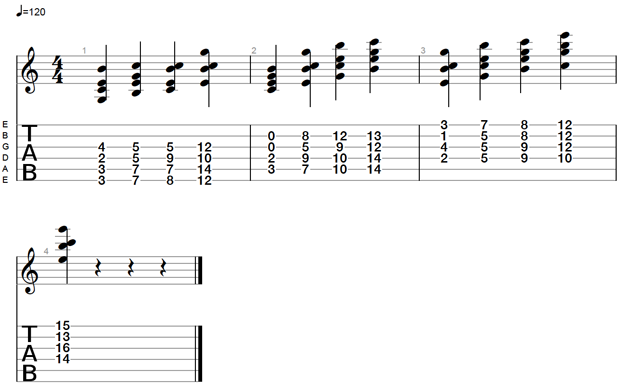The Complete Guitarist: Fun with Chord Inversions

Hey, everyone! Long time, no see. In some of my previous columns, I've discussed arpeggio inversions, but in this installment I'd like to discuss chord inversions and how they can add some color to a typical chord progression.
First, we need to define what a chord inversion is — in case we don't know already. An inversion is a chord in which a different note is at the bottom of the chord besides the root.
Chords are built from the bottom up, usually from the root note; and like my old theory professor Dr. Austin once told me, "Richard, the bass is the boss." So let's take a look at a C major 7th chord. Spelled from the bottom up, this chord would be C E G B.
This would be root position because the C is the lowest note in the chord. But if we placed the E at the lowest note of the chord, which is the 3rd, this would be called first inversion. If we placed the G at the bottom of the chord, which is the 5th, this would be called second inversion. Lastly, if we place the B at the bottom of the chord, which is the 7th, this would be called the third inversion.
So, in a nutshell, this is how we define inversions:
Root note is root position, 3rd on the bottom is first inversion, 5th on the bottom is second inversion and 7th on the bottom is third inversion.
In this example, we are inverting a C major 7th chord all over the fretboard starting on the G on the 3rd fret of the 6th string so the first chord is, you guessed it, in second inversion. The next chord starts on the B at the 7th fret of the 6th string and is in third inversion. The next chord starts on the C at the 8th fret of the 6th string and is in root position and the last chord in the first measure starts on the E at the 12th fret of the 6th string and is in first inversion.
All the latest guitar news, interviews, lessons, reviews, deals and more, direct to your inbox!
You get the picture. Some of these inversions have some long stretches are can be challenging to play but they are definitely unique and bring a great deal of color to the chord itself which in turn can add some spice to an otherwise dull chord progression.
My favorite is the C major 7th chord in first inversion found on the first beat of the third measure. It doesn't sound like a typical major 7th chord which is the whole point of this blog and my whole blog space for that matter; to find your own unique voice on the guitar.
These inversions are moveable chord structures so you can use them all over the fretboard for all major 7th chords. Here's an assignment: try and figure out all the inversions of a D major 7th chord using these structures. Quite challenging for your fingers and brain to say the least.
Thank you all for taking the time to read my blog. Now pick up that guitar and play. Just like yesterday. As always, any feedback and comments are welcome.
Enjoy!

Guitarist Richard Rossicone is a veteran of the New York City and Long Island original and cover band scene. He's been playing since he was 8, when he attended his first concert (Kiss) and saw Pete Townshend smash a guitar. He has studied with various instructors over the years, which led him to a career in music therapy. He began his educational journey at Queensboro Community College, where the faculty introducing him to classical music. He received his associate's degree in fine arts in 1997 and went on to receive his bachelor's in music therapy in 2001 and his master's in music therapy from New York University in 2004. He's been Board Certified as a music therapist since 2002. Richard continued his studies at C.W. Post University, pursuing a second master's degree in classical guitar performance and music history, studying under Harris Becker. He's been teaching guitar, piano and theory since 2002 and in 2006 started his own company, Rossicone Music Studios. Visit him at Axgrinder.com and his Complete Guitarist Facebook page.Check out Richard's new book, 'The Complete Guitarist Handbook: Vol. 1,' which is available at Amazon.com.
